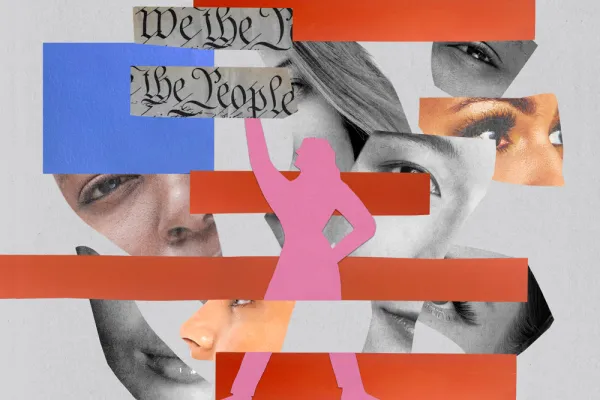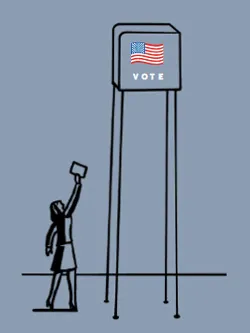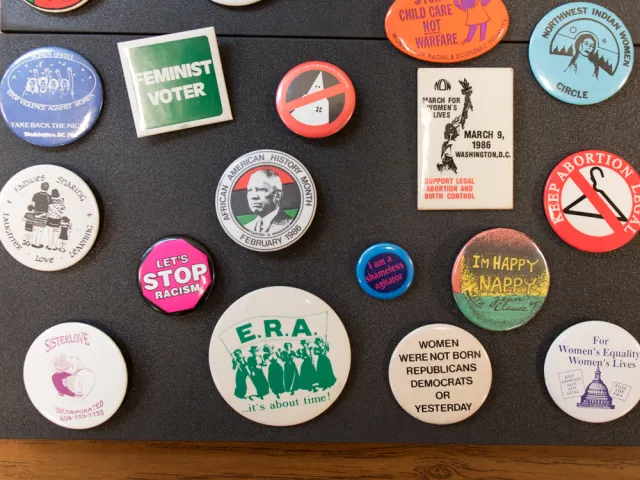Still Unequal
Alum News
Two generations of Smithies discuss the current state of the Equal Rights Amendment and why it matters now more than ever

Published January 10, 2023
Among democratic countries around the world, the United States is an outlier when it comes to guaranteeing rights for individuals based on sex or gender. This means that in America, women do not have the same protections under the law as men. Today, 85% of the 193 United Nations member states have a provision in their constitutions that specifically addresses gender equality, and an additional 115 have a provision that prohibits discrimination on the basis of sex—yet America is not among these countries.
According to Equality Now, a private nonprofit that works to create global equality for women and girls, 80% of Americans believe women have equal rights under the Constitution. “That shows up in poll after poll,” says Sharmila (Mona) Ghosh Sinha ’88, Equality Now’s global director and a longtime gender rights activist. “Anytime I tell people that we do not have equal rights in the Constitution, they are shocked. Women—and anybody who’s not a man—are left out of our Constitution. How can you be a democracy without every citizen having equal rights?”
Gender equality is not a new concept. In 1923, suffragist Alice Paul authored and introduced the Equal Rights Amendment (ERA), a constitutional amendment that stated, in part, “Men and women shall have equal rights throughout the United States and every place subject to its jurisdiction.” Paul worked for the passage of the ERA until her death in 1977.
Today, the implications of a lack of protection for women and LGBTQ+ individuals are clear in the repeal of Roe v. Wade and the erosion of reproductive rights and the escalating attacks on transgender rights.
How is it possible that in almost 100 years, the United States has not passed a simple amendment to protect more than half of its citizens? Sinha and Becca Damante ’17, former senior legislative assistant for the U.S. House of Representatives who completed an archives capstone at Smith on the ERA, offer their comments on the history of the ERA and look at some of the complexities of its journey. In addition, Carrie N. Baker, professor of the study of women and gender at Smith, explores some of the concerns over the decades of those opposing the ERA.
A longtime gender rights activist, Sharmila (Mona) Ghosh Sinha ’88 is the global director of Equality Now, a private nonprofit that works to create equality for women and girls. Photograph by Laylah Amatullah Barrayn
Why We Need the ERA
Mona Sinha ’88: The United States is a global leader, and its identity is based on freedom and equality for all. It seems a glaring omission of everything this country stands for when, essentially, anybody who’s not a man is left out of the Constitution. As a global citizen, I know the whole world is watching and sees the hypocrisy in our efforts to uplift women in areas such as leadership and business when in fact it’s all lip service at the end of the day. Under the law, the United States does not recognize women as equal citizens. What has happened in the past year with the overturning of Roe v. Wade is just the tip of the iceberg. We are already seeing the snowball effects it’s had in other areas such as marriage equality and LGBTQ+ rights. We’ve already seen a big attack on transgender rights across the country, where even parents of transgender children who are accepting are being threatened with prosecution in certain states such as Texas. Laws that have been put into place to protect people are being stripped away, and we’re likely to see more rights fall by the wayside in the aftermath of this decision.
Becca Damante ’17: Many advocates and scholars say that the ERA would protect abortion rights because abortion restrictions discriminate against women. There’s currently a case in Pennsylvania that’s being tested on this. It’s about whether a ban on Medicaid funding for abortion violates Pennsylvania’s state ERA. With the recent Dobbs decision, the [national] ERA could very well protect abortion rights and other reproductive rights that are currently under threat, which is why it’s more important than ever.
Another reason we need the ERA is because Congress has limited power to pass laws to protect women from all sorts of discrimination, including pay and pregnancy discrimination and gender-based violence. For example, in 2000 the Supreme Court heard a case called United States v. Morrison in which a woman named Christy Brzonkala alleged that she was raped by two men while they were students at Virginia Tech. Brzonkala sued under a provision of the Violence Against Women Act, which allowed survivors of gender-based violence to sue their attackers for civil remedies. However, the Supreme Court ruled against Brzonkala and held that Congress did not have the power to enact this provision under the Commerce Clause or the 14th Amendment of the Constitution. Unfortunately, this decision still stands, which means that, under the law, if someone is a survivor of gender-based violence, they cannot sue their attacker for any kind of payment. But if the ERA were added to the Constitution, they could do so.

A former senior legislative assistant for the U.S. House of Representatives, Becca Damante ’17 completed an archives capstone at Smith on the ERA. Photograph by Jared Soares
Where We Stand Now
BD: To be added to the Constitution, an amendment must pass the House and the Senate by a two-thirds majority vote. The House approved the ERA in 1971, and the Senate did the same in 1972. After the amendment was approved by Congress, it had to be ratified by 38 state legislatures. Between 1972 and 1977, 35 states ratified the ERA.
MS: The 30 years between 1977 and 2017 were stagnant. However, in the last five years, the ERA has made it back into the spotlight with Nevada, Illinois, and Virginia becoming the three final states to ratify the amendment in 2017, 2018, and, finally, 2020. I believe the lawmakers and people who pushed this attack on women’s rights saw the threat of women’s movements uniting, gaining steam, and standing up for democracy.

Who’s Afraid of the ERA?
Revealing the Real Opposition to Women’s Constitutional Equality
by Carrie Baker
BD: According to law, once the necessary 38 states have ratified a constitutional amendment, the national archivist—the chief administrator of the U.S. National Archives and Records Administration—must certify and publish it. Unfortunately, since 2020, the national archivist has been refusing to do this based on a legal memo issued by the previous administration. As a result, Nevada, Illinois, and Virginia, which were the last three states to ratify the ERA, sued the archivist, trying to compel the archivist to certify and publish the ERA. The case is currently pending before the D.C. Circuit Court of Appeals. Simultaneously, President Biden has called on Congress to act, arguing that in order for the archivist to certify and publish the ERA, the House and Senate must eliminate the ERA’s deadline for ratification, which was first set for March 22, 1979, and was later extended to June 30, 1982. The House passed a resolution to eliminate this deadline in March 2021, and, as of now, the Senate has not taken a vote. That being said, many ERA advocates argue that the deadline is nonbinding because it was included in the ERA’s preamble, and they believe that President Biden has the power to direct the archivist to certify and publish the ERA immediately.
Where We Go From Here
MS: Wherever you are, start today and be a voice for equality. Be vocal about the fact that women and nonbinary people are not included in our Constitution because that’s a surprising fact for many people. Start those conversations in the classroom or at home. Raise awareness and make it a topic that is elevated. Talk in your community. Make those phone calls to senators and Congress. Urge them to recognize the importance and necessity of the ERA. Be an active voice for the cause because it impacts everything else that we do in our lives. Voting is extremely important because we want the people in Congress and in the Senate to reflect the beliefs and values of the people they represent. Over 70% of Americans believe that abortion is a fundamental right. Yet the protection of that right has been placed on states, and as a result, in some cases, has been taken away altogether. The reality is plain and simple: Our elected officials aren’t acting in our best interests, and that is what they were elected to do. We must hold them accountable.
BD: If you care about LGBTQ+ rights, you should care about the Equal Rights Amendment. In 2020, the Supreme Court ruled that discrimination based on sex also includes discrimination based on sexual orientation and gender identity. This means that if the ERA were added to the Constitution, it would also protect LGBTQ+ people from discrimination based on sexual orientation and gender identity. Given the horrific attacks we are seeing on the LGBTQ+ community across the country, it’s important that queer folks like myself are vocal about the ERA’s impact on our community.
An ERA button is among the items preserved in the Sophia Smith Collection of Women’s History at Smith.
Cheryl Dellecese is a senior editor at Smith.
This story appears in the Winter 2023 issue of the Smith Alumnae Quarterly.
Democracy in Distress
A Special Series

Introduction by Erin Pineda
What is democracy? This seemingly simply question has a seemingly obvious answer: It means, literally and etymologically, that the people rule themselves. But this straightforward reply leads to a tangle of thorny questions: How, exactly, are the people meant to rule themselves? What institutions and procedures enable the people’s rule? Are there limitations on the exercise of popular power—on what the people can elect to do?
PART 1: My Body, But Not My Choice by Andrea Cooper ’83
Navigating a post-Roe world with Candace Gibson ’07 of the National Latina Institute for Reproductive Justice and Genevieve Scott ’06 of the Center for Reproductive Rights.
PART 2: Block the Vote by Andrea Cooper ’83
Voter suppression laws are on the rise. But Smithies are fighting back, working to expand political participation by eliminating ballot restrictions and empowering disenfranchised voters.
PART 3: BANNED by Andrea Cooper ’83
The debate over what constitutes “appropriate” content jeopardizes the open exchange of ideas.
PART 4: When Culture Wars Come for Kids by Oliver Haug ’20
Transgender youth are being attacked by a barrage of new legislation. These Smithies have their backs.
PART 5: Big Little Lies by Andrea Cooper ’83
Disinformation is degrading our democracy. Smithies are striving to shore it up.
PART 6: Still Unequal by Cheryl Dellecese
Two generations of Smithies discuss the current state of the Equal Rights Amendment and why it matters now more than ever.
Illustration by Anthony Russo
Illustration by Franziska Barczyk

